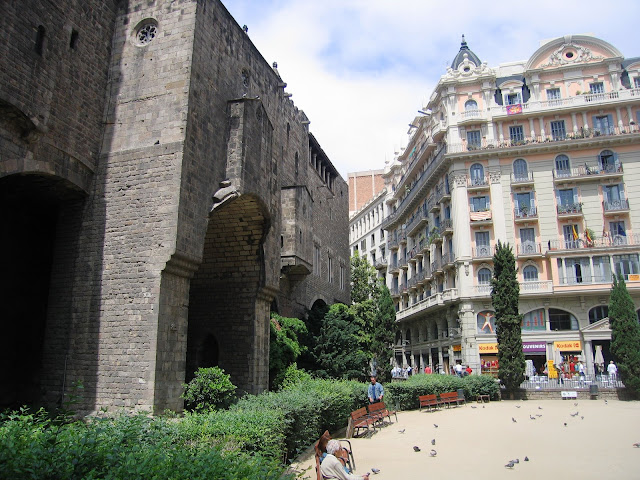Las Ramblas
Barcelona's most famous street, Las Ramblas connects the waterfront and Plaça de Catalunya. Rambla means "and" in Arabic, and centuries ago it was a sandy gully of a river. By 1366 it was a clogged up sewer known as the Cagallel (the turd-taker) clogged wiuith sand. At the end of the 18th century, trees were planted benches, street lights, kiosks and flower stalls added.
Most tourists head here early in their stay. I've got to say it doesn't especially thrill me; human statues mingle with pickpockets and vast crowds wandering aimlessly....
Below: Facade of a former umbrella shop along Las Ramblas (2006)

Below: 'Performance artists' stage a sit-down meal along Las Ramblas. They didn't seem to be making any point other than that they could do what they were doing. (2006)
Bus TurísticMany cities have hop-on /hop-off open-top tourist buses. Barcelona's is one of the best. It takes you to every tourist "hot-spot", is frequent and efficient; a great way to get an overview of the city and work out those places you'd like to explore further.

 Modern Barcelona
Modern Barcelona
Below: Tram tracks along (I think) Avda Diagonal in the university district



La Ribera - The maritime and business district of medieval Barcelona. Includes the Born, now gentrified and much renovated and heavily touristed.
Workers
Below: This is how Barcelona stays so clean - an army of street cleaners. The streets are washed and cleaned every night, and litter patrols are on duty all day


Below: the courtyard of the Picasso Museum in the Born Below: Near Parc Ciutadella...what a strange place to stop for lunch!
Below: Near Parc Ciutadella...what a strange place to stop for lunch!
The Barri Gòtic - Here are the main institutions of medieval BArcelona, overlaying the ruins of Roman Barcelona. In the 1870s, when the city extended outwards into the Eixample (Extension) a 14th century time environment was preserved. This area includes the cathedral, City Hall (Ajuntament) and Catalan regonal government (Generalitat)
Below: Cathedral walls

 Below: The "Bridge of Sighs" a 1928 pastiche.
Below: The "Bridge of Sighs" a 1928 pastiche.

Below: Access can be gained to Montjuïc from Plaça d'Espanya up a series of escalators.

Below: Looking past the Venetian-like towers towards Montjuïc and the National Museuem of Catalunyan Art.
 Below: The Olympic Stadium
Below: The Olympic Stadium

 Camp Nou - the home of Barcelona Football Club
Camp Nou - the home of Barcelona Football ClubBelow: Why not buy a fridge in team colours?
 Estació Barcelona-Sants
Estació Barcelona-Sants Below: taxis and motorbikes
 L'Eixample
L'Eixample Below: Coke, coffee and tapas on Passeig de Gràcia near La Pedrera (see Gaudi entry)







No comments:
Post a Comment